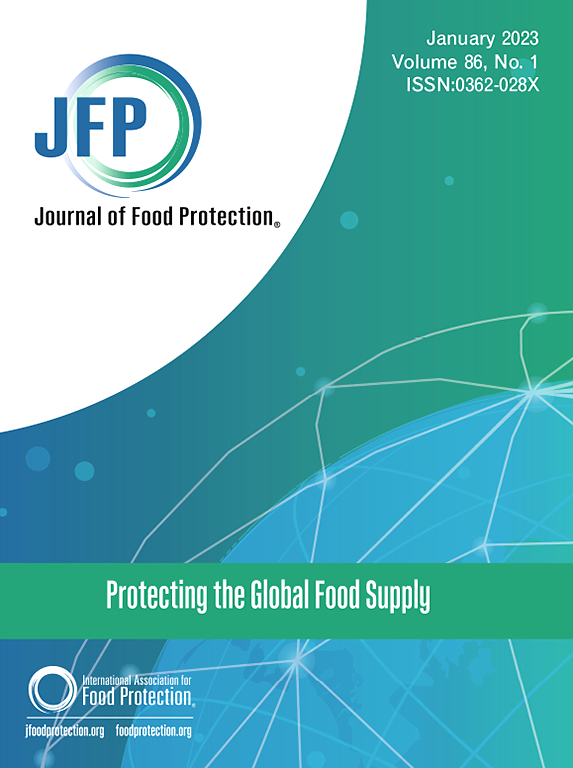Modeling the Impact of Between-lot and Within-lot Variability in Listeria monocytogenes Contamination on Risk Reduction From Sampling Ready-to-eat Foods
IF 2.1
4区 农林科学
Q3 BIOTECHNOLOGY & APPLIED MICROBIOLOGY
引用次数: 0
Abstract
Microbiological sampling and testing are widely utilized in food safety risk management. We developed risk assessments to quantify the impact of various sampling plans on the risk of invasive listeriosis to consumers. We used the FDA-iRISK® tool and adapted available process, consumption, and dose-response modules of published L. monocytogenes risk assessments to predict cases per billion servings from consumption of ready-to-eat foods. We also developed an ad hoc quantitative risk assessment application using R (the “FDA-LmQRA App”) to evaluate more complex scenarios and provide additional metrics. Data and model inputs included the prevalence and levels of L. monocytogenes, sampling plan parameters, and operating characteristic curve data. We derived prevalence and between-lot distributions from data from market basket surveys of L. monocytogenes in ready-to-eat foods in the U.S. and examined two assumptions for the within-lot contamination: a lognormal distribution, or a heterogeneous distribution with a defined proportion of exceptional (higher level) contamination in addition to a single lognormal distribution. We found that testing each lot using 2-class plans (e.g., n = 5 or 10, m = 0/25 g or 0/5 g, and c = 0) or 3-class mixed plans (e.g., n = 5 or 10, m = 0/25 g or 0/5 g, M = 20 CFU/g or 100 CFU/g, and c = 1) and replacing positive lots by noncontaminated lots predicted quantifiable, but relatively low, risk reduction. The risk estimates were highly influenced by the variability of the between-lot concentration distribution as well as the presence of exceptional contamination for the within-lot contamination. In the presence of exceptional contamination, a 3-class mixed plan (c = 1) was predicted to have comparable performance based on risk estimates to a 2-class plan (corresponding n and m but c = 0). Results from this study may inform the choice of sampling plans to optimize sampling and testing strategies for reducing listeriosis associated with ready-to-eat foods.
模拟单核细胞增生李斯特菌污染批次间和批次内变异对即食食品取样降低风险的影响。
微生物采样和检测在食品安全风险管理中应用广泛。我们制定了风险评估,以量化各种抽样计划对消费者侵袭性李斯特菌病风险的影响。我们使用FDA-iRISK®工具,并采用已发表的单核增生乳杆菌风险评估的现有流程、消耗和剂量反应模块来预测每10亿份即食食品的病例。我们还使用R开发了一个特别的定量风险评估应用程序(“FDA-LmQRA应用程序”)来评估更复杂的场景并提供额外的指标。数据和模型输入包括单核增生乳杆菌的患病率和水平、采样计划参数和工作特征曲线数据。我们从美国即食食品中单核增生乳杆菌的市场篮子调查数据中得出流行率和批次间分布,并检查了批次内污染的两种假设:对数正态分布,或者除了单一对数正态分布外,具有特定比例的异常(较高水平)污染的异质分布。我们发现,使用2级方案(例如,n=5或10,m=0/25 g或0/5 g, c=0)或3级混合方案(例如,n=5或10,m=0/25 g或0/5 g, m= 20 CFU/g或100 CFU/g, c=1)测试每个批次,并用未污染的批次替换阳性批次,预测可量化但相对较低的风险降低。风险估计高度受到批次间浓度分布的可变性以及批次内污染异常污染的存在的影响。在存在异常污染的情况下,根据风险估计,预测3级混合计划(c=1)与2级计划(对应n和m,但c=0)具有相当的性能。本研究的结果可以为选择采样计划提供信息,以优化采样和检测策略,以减少与即食食品相关的李斯特菌病。
本文章由计算机程序翻译,如有差异,请以英文原文为准。
求助全文
约1分钟内获得全文
求助全文
来源期刊

Journal of food protection
工程技术-生物工程与应用微生物
CiteScore
4.20
自引率
5.00%
发文量
296
审稿时长
2.5 months
期刊介绍:
The Journal of Food Protection® (JFP) is an international, monthly scientific journal in the English language published by the International Association for Food Protection (IAFP). JFP publishes research and review articles on all aspects of food protection and safety. Major emphases of JFP are placed on studies dealing with:
Tracking, detecting (including traditional, molecular, and real-time), inactivating, and controlling food-related hazards, including microorganisms (including antibiotic resistance), microbial (mycotoxins, seafood toxins) and non-microbial toxins (heavy metals, pesticides, veterinary drug residues, migrants from food packaging, and processing contaminants), allergens and pests (insects, rodents) in human food, pet food and animal feed throughout the food chain;
Microbiological food quality and traditional/novel methods to assay microbiological food quality;
Prevention of food-related hazards and food spoilage through food preservatives and thermal/non-thermal processes, including process validation;
Food fermentations and food-related probiotics;
Safe food handling practices during pre-harvest, harvest, post-harvest, distribution and consumption, including food safety education for retailers, foodservice, and consumers;
Risk assessments for food-related hazards;
Economic impact of food-related hazards, foodborne illness, food loss, food spoilage, and adulterated foods;
Food fraud, food authentication, food defense, and foodborne disease outbreak investigations.
 求助内容:
求助内容: 应助结果提醒方式:
应助结果提醒方式:


